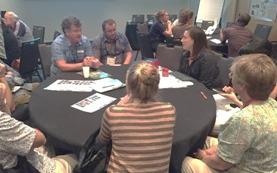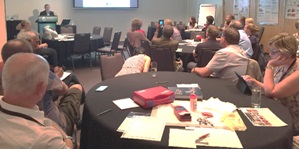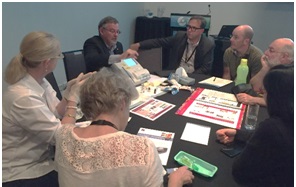Point-of-care testing workshop held in Cairns.

A workshop titled ‘Point-of-Care Testing for Today’s Family Doctor: Innovations and Applications’ was presented by Professor Mark Shephard, Lara Motta, Tessa McCormack and Brooke Spaeth on behalf of the
WONCA Special Interest Group on Point-of-Care Testing at the 14th WONCA World Rural Health Conference in Cairns, Queensland, Australia, 29th April – 2nd May 2017.
At the Workshop, Professor Shephard (Chair of the SIG on Global POCT) gave a presentation which provided participants with an understanding of how POCT is applicable to their practice as family doctors and a brief overview of the work of the SIG and the results of our ongoing survey. Mark also presented working examples of national and international POCT networks operating in the rural and remote primary care sector, including POCT networks for acute medical presentations, for diagnosis and management of diabetes and renal disease, for the detection of sexually transmitted infections and for the detection and management of anaemia.

Following Mark’s presentation, the group was split into five groups for the ‘point-of-care speed-dating’ session. Participants moved from table to table where they were given a practical demonstration of a range of POCT devices used to detect and manage chronic, acute and infectious diseases. The devices encompassed POCT technologies ranging from lateral flow strips and immunoassays to real-time molecular diagnostics, electrochemical detection and cell counting based on facial recognition technology. Participants had the chance to try out the devices first-hand and discuss the use of POCT.
Over 30 participants attended the workshop, with most participants coming from the host country of Australia, and neighbouring New Zealand, as well as participants from the Philippines, Canada and Nigeria. Discussions around the tables were focussed on what types of POCT participants were currently using, what they would like to have available to use and what they saw as barriers to the use of POCT in their practice. The most commonly used POCT device by the participants was the i-STAT, with doctors from NZ and rural Australia using it mainly for INR, blood gases, and troponin. Other tests included pregnancy testing, full blood cell count, glucose and ultrasounds.
An Australian GP made the comment that, ‘why isn’t there was one machine to do the 10 most common POC tests: electrolytes, full blood count/white blood cell count, platelets, urea, inflammatory markers/BSL, liver function, troponin…’ which led to debate about which 10 tests are the most common/important. A doctor from Nigeria stated that in Nigeria ‘… sometimes the distance from the hospital to laboratory may only be 10km, but during peak times, traffic can make this journey take up to 3 hours. We have in-house HbA1c testing but I would like electrolytes and creatinine, full blood counts, lipids and blood gases’.
One participant noted that the workshop helped increased their knowledge that POCT does not necessarily need to be for urgent tests only, as some tests make a difference to the patient’s overall management (e.g. HbA1c and ACR for diabetes). Discussions quickly turned to the cost of POCT with one participant suggesting that, without government funding, the technology is currently too expensive. Another commented that there seems to be a growing acceptance that out of pocket expenses may be necessary to facilitate POCT as traditional reimbursement pathways are difficult to navigate.

At the end of the workshop, 13 new members joined our Special Interest Group.
For more information or to join the SIG, visit the
WONCA SIG on Point-of-Care Testing.
Access the
short survey on POCT
Join our SIG